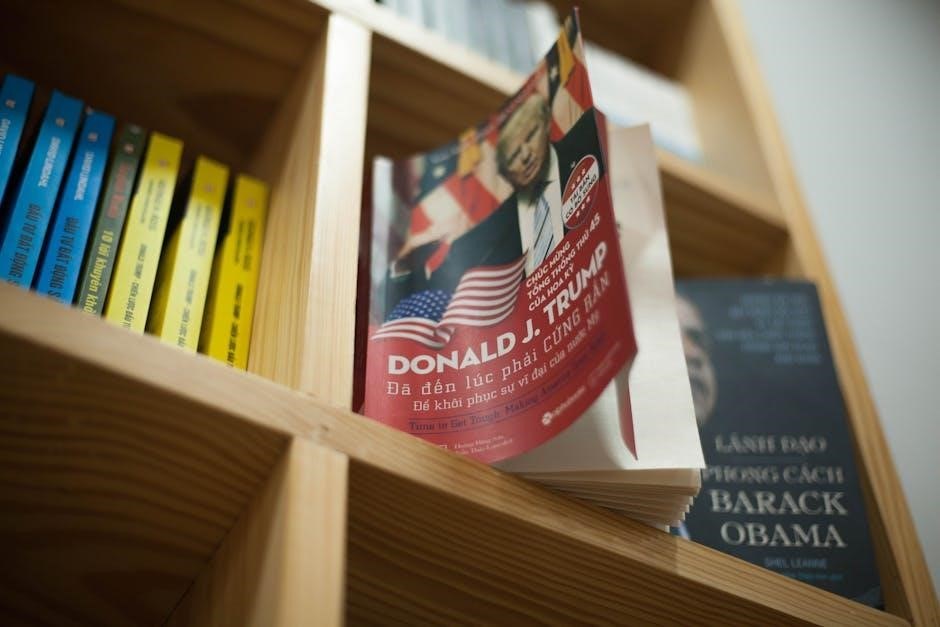nghệ thuật đàm phán donald trump pdf
Donald Trump’s The Art of the Deal offers insights into negotiation, emphasizing confidence, emotional intelligence, and leverage․ A must-read for entrepreneurs, it explores Trump’s business philosophy and strategies, blending practical advice with real-world examples, making it a timeless guide for leaders aiming to master deal-making and achieve success․
1․1 Overview of the Book
Published in 2016, Nghệ thuật đàm phán (The Art of the Deal) by Donald J․ Trump and Tony Schwartz is a compelling blend of memoir and business guide․ The book delves into Trump’s experiences as a real estate magnate, offering insights into negotiation strategies, deal-making, and leadership․ Filled with real-world examples, it explores themes like confidence, leverage, and emotional intelligence․ Translated by Nguyễn Đăng Thiều, the Vietnamese edition has resonated with readers, making it a must-read for aspiring entrepreneurs and leaders seeking practical advice on achieving success in business and life․
1․2 Key Themes and Lessons
The book emphasizes confidence, calculated risk-taking, and leveraging power in negotiations․ Trump highlights the importance of emotional intelligence, understanding counterpart needs, and maintaining control․ Practical lessons include maximizing gains, knowing when to walk away, and the power of persistence․ Readers gain insights into deal-making, conflict resolution, and building strong relationships․ These themes, rooted in Trump’s business philosophy, provide actionable strategies for success in both personal and professional spheres, making the book a valuable resource for entrepreneurs and leaders alike․
1․3 Importance of the Book in Modern Business
“The Art of the Deal” remains a cornerstone in modern business literature, offering timeless strategies for negotiation and deal-making․ Its principles, such as maximizing leverage and understanding counterpart motivations, are highly relevant in today’s competitive landscape․ The book provides practical insights into building relationships, managing risks, and adapting to market changes․ Entrepreneurs and executives continue to draw value from its lessons, making it an essential resource for navigating the complexities of contemporary business environments effectively and strategically․

Donald Trump’s Negotiation Strategies
Donald Trump’s negotiation strategies emphasize confidence, leverage, and emotional intelligence, focusing on bold opens, maximizing advantages, and applying pressure while maintaining calculated risk-taking for optimal results․
2․1 Confidence as a Core Principle
Confidence is central to Donald Trump’s negotiation approach, as outlined in Nghệ thuật đàm phán․ Trump emphasizes projecting self-assurance to influence outcomes․ He believes confidence not only commands respect but also creates an aura of authority, making others more likely to concede․ This mindset allows him to set the tone early, assert dominance, and maintain control throughout negotiations․ By showcasing unwavering belief in his positions, Trump often intimidates opponents, giving him a psychological edge․ This principle is repeatedly highlighted in his book as a key driver of his success in high-stakes deals․
2․2 The Role of Leverage in Negotiations
Leverage is a cornerstone of Trump’s negotiation strategy, as detailed in Nghệ thuật đàm phán․ He stresses the importance of identifying and exploiting advantages to gain the upper hand․ Whether through exclusive deals, limited supply, or unique offerings, leverage allows Trump to dictate terms and force concessions․ By creating a sense of urgency or scarcity, he pressures counterparts to comply, ensuring favorable outcomes․ This tactic, rooted in calculated risk-taking, underscores his ability to maximize gains in high-stakes negotiations, as repeatedly illustrated in his book․
2․3 Emotional Intelligence in Deal-Making
Emotional intelligence plays a pivotal role in Trump’s negotiation tactics, as highlighted in Nghệ thuật đàm phán․ He emphasizes understanding counterpart emotions to tailor approaches, fostering rapport, and using empathy to uncover priorities․ By staying calm under pressure, Trump maintains composure, a strategic advantage․ His ability to read and manipulate emotions enables him to steer negotiations favorably․ This skill, combined with persuasive communication, allows him to align deals with mutual interests, ensuring satisfaction and long-term relationships, as demonstrated in his successful business ventures and partnerships․ Emotional intelligence is thus a key tool in his negotiation arsenal․
2․4 Handling Conflict and Competition
Trump’s approach to conflict and competition in Nghệ thuật đàm phán revolves around assertiveness and strategic positioning․ He advocates for an aggressive yet calculated approach, ensuring opponents recognize the stakes․ Walking away is a powerful tactic to renegotiate terms․ Trump emphasizes leveraging competition to create pressure, fostering an environment where counterparts feel compelled to concede․ Maintaining composure under duress is crucial, as emotional control often dictates outcomes․ This mindset allows Trump to turn adversarial situations into advantageous deals, showcasing his ability to thrive in competitive landscapes and emerge victorious․ Conflict, for Trump, is an opportunity to strengthen positions․

Trump’s Business Philosophy
Trump’s business philosophy centers on bold thinking, rapid decision-making, and maintaining a “winner’s mentality․” Success, he believes, stems from confidence, calculated risks, and relentless pursuit of excellence․
3․1 The Power of Branding
Branding is a cornerstone of Trump’s business philosophy, emphasizing the creation of a strong, recognizable identity․ A powerful brand, he argues, commands respect, builds trust, and drives value․ Trump illustrates how his own brand became synonymous with luxury and success, enabling him to negotiate favorable deals․ He stresses that a strong brand is not just a logo but a reflection of quality and reliability, giving businesses a competitive edge in any market․ This philosophy underscores the importance of perception in achieving long-term success;
3․2 Risk Management and Calculated Moves
Trump underscores the importance of calculated risk-taking in business negotiations․ He advocates for thorough preparation and due diligence to minimize potential pitfalls․ By understanding the risks and rewards, one can make informed decisions that align with long-term goals․ Trump’s approach involves assessing the upside and downside of every deal, ensuring that risks are manageable and aligned with strategic objectives․ This philosophy emphasizes prudence over reckless boldness, demonstrating how smart risk management can lead to profitable and sustainable outcomes in negotiations․
3․3 Building Relationships and Networks
Trump emphasizes the significance of fostering strong relationships and networks in business negotiations․ He believes that cultivating trust and mutual respect lays the foundation for successful deals․ By nurturing relationships, individuals can create a network of allies who can provide support and opportunities․ Trump’s approach highlights the value of long-term partnerships, ensuring that both parties benefit․ His ability to connect with people and build rapport has been instrumental in his success, demonstrating how relationships can serve as a powerful tool in achieving business objectives․
3․4 Adaptability in Business Deals
Adaptability is a cornerstone of Trump’s negotiation philosophy, allowing him to pivot strategies based on evolving circumstances․ He stresses the importance of remaining flexible to capitalize on new opportunities and mitigate risks․ By staying attuned to market shifts and counterpart dynamics, Trump demonstrates how adaptability can turn potential setbacks into advantages․ His willingness to adjust plans while maintaining core objectives underscores the value of resilience in achieving long-term success in competitive business environments․

Psychological Aspects of Trump’s Approach
Trump’s approach leverages psychological tactics to read opponents, create leverage, and build rapport․ His ability to understand human behavior and manipulate perceptions is central to his negotiation success․
4․1 Understanding Human Behavior in Negotiations
Trump’s negotiation strategy heavily relies on understanding human behavior, allowing him to tailor his approach to each counterpart․ By reading motivations, emotions, and limits, he gains an upper hand․ Trump emphasizes the importance of knowing when to push and when to compromise, leveraging psychological insights to create advantageous deals․ This ability to decode human behavior enables him to anticipate reactions and adjust tactics mid-negotiation, ensuring he maintains control and achieves desired outcomes․
4․2 The Impact of Body Language
Body language plays a pivotal role in Trump’s negotiation tactics, as it conveys confidence and authority․ His approach emphasizes maintaining an assertive posture, direct eye contact, and controlled gestures to project power․ By aligning his body language with his verbal messaging, Trump creates a cohesive and persuasive presence․ This non-verbal communication helps him gauge the other party’s reactions and adjust his strategy accordingly․ Mastering body language allows Trump to subtly influence negotiations, reinforcing his position and building an aura of control and dominance in any deal-making scenario․

4․3 Using Persuasion Techniques
Trump’s negotiation style heavily relies on persuasion techniques to influence outcomes․ He uses repetition to reinforce key points, making them memorable and impactful․ Storytelling is another tool, allowing him to connect emotionally with counterparts․ Trump also employs anchoring, starting with extreme offers to create room for compromise․ These tactics, combined with his charismatic delivery, help him steer negotiations in his favor, making his arguments more compelling and difficult to counter․ Persuasion is central to his ability to secure advantageous deals and maintain the upper hand in negotiations․
4․4 Maintaining a Winning Mindset
Trump emphasizes the importance of maintaining a winning mindset in negotiations․ He believes in exuding confidence and mental toughness to intimidate opponents․ By focusing on success rather than failure, Trump creates an aura of inevitability around his desired outcomes․ Visualizing victory and embracing a “can-do” attitude are central to his approach․ This mindset allows him to stay resilient, adapt under pressure, and outmaneuver competitors․ A winning mindset, according to Trump, is the foundation for achieving success in both business and life, ensuring one remains in control and poised for victory․

Case Studies from the Book
Real-world examples from Trump’s career, including the Trump Tower deal, casino negotiations, renegotiation strategies, and lessons from failed deals, illustrate his negotiation tactics effectively․
5․1 The Trump Tower Deal
The Trump Tower deal exemplifies Trump’s mastery of negotiation․ By leveraging his reputation and vision, he secured prime Manhattan real estate despite initial skepticism․ His ability to persuade stakeholders and negotiate favorable terms showcased his confidence and tactical acumen․ The deal’s success highlights Trump’s emphasis on maximizing value and maintaining control, demonstrating how strategic negotiation can turn ambitious projects into reality․ This case study underscores the importance of persistence and creative deal-making in achieving business triumphs․
5․2 Negotiating with Casino Partners
Trump’s negotiations with casino partners highlight his skill in creating advantageous alliances․ He focused on structuring deals that ensured long-term profitability while maintaining control․ By understanding the interests of all parties, he crafted agreements that balanced risk and reward․ His approach emphasized clarity, fairness, and mutual benefit, which fostered trust and cooperation․ These negotiations demonstrate how strategic collaboration can lead to successful outcomes, aligning with his philosophy of win-win deals that strengthen business relationships and drive growth․ This strategy remains a cornerstone of his negotiation legacy․
5․3 The Art of Renegotiation
Trump’s approach to renegotiation emphasizes boldness and precision․ He believes in revisiting deals to maximize benefits, even after initial agreements․ By leveraging timing and persistence, he demonstrates how to refine terms for improved outcomes․ Renegotiation, in his view, is not about confrontation but about aligning interests for mutual gain․ This strategy highlights his adaptability and ability to capitalize on evolving circumstances, ensuring deals remain advantageous․ His techniques in renegotiation showcase his mastery in maintaining power while preserving relationships, a key aspect of his negotiation philosophy․
5․4 Lessons from Failed Deals
Trump’s approach to failed deals highlights resilience and learning․ He views failures as opportunities to refine strategies and improve future negotiations․ In The Art of the Deal, he shares insights from setbacks, such as overvaluing assets or misjudging partners․ These experiences taught him the importance of due diligence and adaptability․ Trump emphasizes that understanding what went wrong is crucial for growth․ His philosophy underscores that every failure brings valuable lessons, shaping smarter decisions and stronger negotiating positions in the future․ This mindset is central to his business success and enduring legacy․

The Art of the Deal in the Digital Age
Trump’s negotiation strategies adapt seamlessly to the digital age, emphasizing technology, data-driven decisions, and online presence․ Modern business demands agility and innovation, aligning with Trump’s core principles of leveraging opportunities and staying ahead in competitive markets․
6․1 Applying Trump’s Strategies to Modern Business
Trump’s negotiation tactics remain relevant in the digital age, emphasizing adaptability, bold action, and leveraging technology․ Businesses can apply his principles by using data analytics to strengthen bargaining positions and embracing digital platforms for deal-making․ Social media and online branding have become crucial tools, aligning with Trump’s focus on reputation and visibility․ By combining traditional negotiation skills with modern digital strategies, companies can maintain a competitive edge in today’s fast-paced market․
6․2 Negotiation in the Age of AI and Automation
Negotiation in the age of AI and automation requires blending traditional strategies with technological advancements; AI tools can analyze data, predict outcomes, and optimize offers, enhancing negotiation preparation․ Automation streamlines communication and accelerates deal closures․ However, emotional intelligence and strategic thinking remain irreplaceable․ Trump’s emphasis on confidence and leverage aligns with AI-driven insights, enabling negotiators to make informed, bold decisions․ Balancing human intuition with AI capabilities is crucial for mastering modern negotiations․
6․3 The Role of Social Media in Deal-Making
Social media has revolutionized deal-making by enabling real-time communication and amplifying negotiation strategies․ Platforms like Twitter and Instagram allow direct engagement with stakeholders, fostering relationships and brand visibility․ Trump leveraged social media to negotiate publicly, creating buzz and pressure․ It enables rapid feedback, helping negotiators adapt․ However, transparency can also lead to scrutiny․ Social media’s viral nature can turn small deals into massive opportunities, making it a powerful tool for modern negotiators to influence outcomes and build credibility in real-time․
6․4 Ethical Considerations in Digital Negotiations
Digital negotiations raise ethical concerns, such as privacy, transparency, and data security․ The speed and anonymity of online interactions can blur boundaries, making it easier to misrepresent information․ Ethical negotiators must maintain honesty and fairness, even in virtual settings․ Trump’s approach emphasizes winning, but digital deals demand accountability to avoid exploitation․ Ensuring confidentiality and respecting counterparties’ rights are crucial․ Ethical digital negotiations build trust and long-term relationships, balancing competitiveness with integrity in the fast-paced online world․

The Impact of “Nghệ thuật đàm phán” on Readers
The book empowers readers with practical negotiation skills, inspiring confidence and strategic thinking, while provoking reflection on ethics and personal growth in business and life․
7․1 Inspiring Entrepreneurs and Leaders
Trump’s book motivates entrepreneurs and leaders to embrace boldness and resilience․ By sharing real-world examples, it equips readers with confidence to pursue ambitious goals and negotiate effectively․ The emphasis on calculated risks and creative problem-solving encourages innovation, while the focus on persistence inspires leaders to overcome setbacks․ Many readers report feeling empowered to take control of their business dealings and approach challenges with a winner’s mindset, making the book a catalyst for personal and professional growth․
7․2 Transforming Negotiation Styles
Trump’s strategies have revolutionized negotiation approaches, fostering a more assertive and results-driven mindset․ Readers learn to adopt a collaborative yet firm stance, focusing on mutual benefits while maintaining control․ The book encourages thinking outside the box, using unconventional tactics to achieve advantageous deals․ By mastering the art of leveraging power and timing, individuals can transform their negotiation styles, becoming more confident and effective in securing favorable outcomes․ This shift empowers professionals to approach negotiations with a proactive and strategic perspective․
7․3 Practical Applications of the Book’s Teachings
Readers can apply Trump’s negotiation tactics in real-world scenarios, such as business deals, partnerships, and even everyday interactions; The book teaches how to use leverage, understand the opponent’s perspective, and create win-win situations․ Practical lessons include knowing when to walk away, the power of persistence, and the importance of preparation․ These strategies can be implemented in various industries, from real estate to entrepreneurship, helping individuals achieve their goals more effectively․ The teachings emphasize adaptability and confidence, making them universally applicable․
7․4 Criticisms and Controversies
Some critics argue that Trump’s negotiation tactics, as outlined in “The Art of the Deal,” can be overly aggressive and manipulative․ Others question the ethics of his “win-at-all-costs” approach, suggesting it may harm long-term relationships․ Additionally, critics point out that his methods may not be universally applicable, as they rely heavily on his personal brand and leverage․ Despite its popularity, the book has faced scrutiny for promoting a combative rather than collaborative approach to business, sparking debates about its practicality in modern, diverse business environments․

Comparison with Other Negotiation Strategies
Trump’s negotiation strategies differ from traditional methods, emphasizing confidence and leverage over collaboration․ His approach aligns with assertive leadership styles but contrasts with consensus-driven techniques․
8․1 Trump vs․ Traditional Negotiation Methods
Trump’s negotiation style contrasts sharply with traditional methods, which often emphasize collaboration and mutual benefit․ His approach prioritizes confidence, leverage, and assertiveness, sometimes at the expense of long-term relationships․ Traditional negotiation focuses on compromise and creating value for both parties, whereas Trump’s tactics often involve aggressive opening offers and a “win-at-all-costs” mentality․ This divergence highlights fundamentally different philosophies: Trump’s method is more adversarial, while traditional approaches aim for sustainable partnerships and trust-building․
8․2 Similarities with Other Leadership Philosophies
Trump’s negotiation philosophy shares similarities with other assertive leadership styles, such as those of Sun Tzu or Lee Kuan Yew․ Like these figures, Trump emphasizes confidence, strategic thinking, and the use of leverage to achieve goals․ His approach aligns with the “win-win” mentality in some aspects, as he seeks advantageous deals while satisfying all parties․ However, his focus on personal brand and dominance sets him apart, reflecting a unique blend of competitiveness and pragmatism that resonates with leaders who prioritize bold action over passive cooperation․
8;3 Contrasting Approaches in Global Business
Trump’s negotiation style differs significantly from many global business approaches, which often prioritize collaboration and long-term relationships․ While Trump focuses on assertiveness and short-term gains, other cultures, like in Asia or Europe, emphasize harmony and mutual benefit․ For instance, Japanese and Scandinavian businesses often value consensus over competition, contrasting with Trump’s “win-at-all-costs” mentality․ These differences highlight the diversity of negotiation philosophies worldwide, underscoring the importance of cultural awareness in global deal-making․ Trump’s approach, while effective in certain contexts, may not align with the values of more cooperative business environments․
8․4 The Evolution of Negotiation Tactics
Negotiation tactics have evolved significantly over time, shifting from rigid, adversarial approaches to more strategic and nuanced methods․ Trump’s approach, as outlined in “The Art of the Deal,” emphasizes confidence, leverage, and psychological insight, reflecting a modern, assertive style․ In contrast, earlier negotiation models often focused on compromise and passive tactics․ The rise of globalization and digital communication has further transformed negotiations, requiring adaptability and cultural awareness․ Today, negotiators blend traditional strategies with innovative techniques, making Trump’s principles a benchmark for understanding modern deal-making dynamics and their continuous evolution in response to changing business landscapes․

The Role of Llama Models in Understanding Negotiation
Llama models analyze negotiation strategies, offering insights and enhancing modern negotiators’ efficiency and decision-making by leveraging AI-driven data processing and pattern recognition capabilities effectively always․
9․1 AI’s Role in Analyzing Trump’s Strategies
Llama models, like advanced AI systems, play a crucial role in dissecting Trump’s negotiation tactics by identifying patterns, key principles, and actionable insights from his strategies․ These models can analyze vast amounts of data, including Trump’s deals, speeches, and writings, to uncover underlying psychological and tactical elements․ AI provides objective, data-driven perspectives on Trump’s approaches, enabling modern negotiators to adapt and refine these methods effectively․ This capability enhances understanding and practical application of his techniques in contemporary business environments․
9․2 Llama 3 and Llama 4 Capabilities in Negotiation Analysis
Llama 3 and Llama 4 models excel in analyzing negotiation strategies by processing vast texts, identifying key patterns, and extracting actionable insights․ These advanced AI tools can dissect Trump’s tactics, such as his use of leverage and emotional intelligence, providing deeper understanding․ They enable comparison of Trump’s methods with traditional negotiation theories, offering a comprehensive analysis․ Their capabilities enhance the study of negotiation strategies, making them invaluable for modern negotiators seeking to refine their approaches based on proven techniques․
9․3 AI-Driven Insights for Modern Negotiators
AI models offer negotiators data-driven insights, enhancing their ability to predict outcomes and tailor strategies․ By analyzing patterns in communication and behavior, AI provides real-time feedback, enabling negotiators to adapt Trump’s tactics, like leveraging emotional intelligence, to contemporary scenarios․ These tools also help identify optimal deal terms, fostering win-win outcomes․ AI’s analytical power complements human intuition, making negotiations more efficient and effective in today’s fast-paced business environment․
9․4 The Future of AI in Business Negotiations
AI is poised to revolutionize business negotiations by enabling smarter, data-driven decision-making․ Advanced models will analyze vast datasets to predict counterpart behaviors, optimize deal terms, and identify hidden opportunities․ AI tools will also enhance personalization, allowing negotiators to tailor strategies to specific scenarios․ As AI evolves, it will become an indispensable partner in negotiations, combining human creativity with machine precision to achieve superior outcomes․ This synergy will redefine modern deal-making, making it faster, more efficient, and strategically aligned with Trump’s negotiation principles․
10․1 Final Thoughts on Trump’s Negotiation Art
Donald Trump’s negotiation art, as outlined in “The Art of the Deal,” emphasizes confidence, leverage, and emotional intelligence․ His strategies, while controversial, offer practical insights into deal-making․ By understanding human behavior and maintaining a winning mindset, Trump demonstrates how adaptability and boldness can lead to success․ However, critics argue his methods may lack ethical depth․ Despite this, his approach remains a valuable study in modern negotiation tactics, encouraging readers to think strategically and embrace calculated risks in business and life․
10․2 The Timeless Relevance of “The Art of the Deal”
Donald Trump’s “The Art of the Deal” remains a timeless guide to negotiation and business strategy․ Its core principles—such as maximizing leverage, understanding human psychology, and embracing adaptability—are universally applicable; While written decades ago, the book’s insights resonate in today’s fast-paced, globalized world․ Its emphasis on confidence, calculated risks, and relationship-building continues to inspire entrepreneurs and leaders․ The book’s enduring popularity underscores its relevance, offering practical wisdom that transcends industries and generations․
10․3 Encouragement to Apply the Strategies
Readers are urged to embrace Trump’s negotiation strategies, as they offer practical tools for achieving success․ By cultivating confidence, leveraging opportunities, and understanding human behavior, individuals can enhance their deal-making skills․ These principles are adaptable to various aspects of life, from business to personal relationships․ Encouraging proactive application, the book motivates readers to think boldly and act decisively, ensuring they maximize their potential in every negotiation․ The strategies outlined are timeless, empowering individuals to navigate modern challenges with clarity and effectiveness․
10․4 The Legacy of Donald Trump’s Business Philosophy
Donald Trump’s business philosophy, as detailed in “The Art of the Deal,” has left an indelible mark on modern business practices․ His emphasis on confidence, branding, and calculated risk-taking has inspired countless entrepreneurs․ While controversial, his strategies have reshaped how many approach negotiations, emphasizing the importance of leveraging power and adaptability․ Love him or hate him, Trump’s influence on deal-making remains undeniable, sparking debates and discussions that continue to shape the business world․ His legacy endures as a polarizing yet impactful figure in business history․
